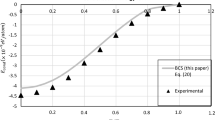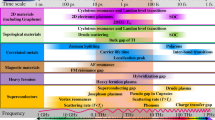The combination of strongly coupled Cooper pairs and weak superconducting fluctuations is an important prerequisite for achieving high-temperature superconductivity. The review is devoted to the implementation of this condition in multiband superconductors, in which strongly coupled pairs in the shallow conduction band (the Fermi level is close to the band edge) coexist with ordinary, weakly fluctuating Cooper pairs formed in the deep band. As a result of the Josephson coupling between condensates in different bands, such a system is characterized by a high critical coherence temperature due to the presence of strongly coupled pairs and the suppression of superconducting fluctuations. This suppression does not require any special preconditions, and is almost total even if the Josephson coupling between the bands is weak.













Similar content being viewed by others
Change history
05 March 2024
An Erratum to this paper has been published: https://doi.org/10.1134/S0021364024020012
REFERENCES
J. Bardeen, L. N. Cooper, and J. R. Schrieffer, Phys. Rev. B 108, 1175 (1957).
J. G. Bednorz and K. A. Müller, Zeitschr. Phys., B 64, 189 (1957).
V. J. Emery and S. A. Kivelson, Nature (London, U.K.) 374, 434 (1995).
M. Buchanan, Nature (London, U.K.) 409, 8 (2001).
M. V. Sadovskii, Phys. Usp. 44, 515 (2001).
C. Varma, Nature (London, U.K.) 468, 184 (2010).
S. I. Vedeneev, Phys. Usp. 64, 890 (2021).
S. Borisenko, Nat. Mater. 12, 600 (2013).
I. M. Lifshitz, Sov. Phys. JETP 38, 1569 (1969).
G. E. Volovik, Low Temp. Phys. 43, 47 (2017).
A. I. Coldea and M. D. Watson, Ann. Rev. Condens. Matter Phys. 9, 125 (2018).
J. Ketterson and S. Song, Superconductivity (Cambridge Univ. Press, Cambridge, UK, 1999).
A. Larkin and A. Varlamov, Theory of Fluctuations in Superconductors (Oxford Univ. Press, Oxford, USA, 2005).
K. B. Efetov and A. I. Larkin, Sov. Phys. JETP 39, 1129 (1974).
L. P. Gor’kov and I. E. Dzyaloshinskii, Sov. Phys. JETP 40, 198 (1975).
D. Jérome, A. Mazaud, M. Ribault, and K. Bechgaard, J. Phys. Lett. 41, 95 (1980).
Y. Lubashevsky, E. Lahoud, K. Chashka, D. Podolsky, and A. Kanigel, Nat. Phys. 8, 309 (2012).
K. Okazaki, Y. Ito, Y. Ota, Y. Kotani, T. Shimojima, T. Kiss, S. Watanabe, C.-T. Chen, S. Niitaka, T. Hanaguri, H. Takagi, A. Chainani, and S. Shin, Sci. Rep. 4, (2014).
S. Kasahara, T. Watashige, Y. K. T. Hanaguri, T. Yamashita, Y. Shimoyama, Y. Mizukami, R. Endo, H. Ikeda, A. Kazushi, T. Terashima, S. Uji, T. Wolf, H. von Löhneysenf, T. Shibauchi, and Y. Matsuda, Proc. Natl. Acad. Sci. U. S. A. 111, 16309 (2014).
S. Rinott, K. B. Chashka, A. Ribak, E. D. L. Rienks, A. Taleb-Ibrahimi, P. L. Fevre, F. Bertran, M. Randeria, and A. Kanigel, Sci. Adv. 3, e1602372 (2017).
T. Hanaguri, S. Kasahara, J. Böker, I. Eremin, T. Shibauchi, and Y. Matsuda, Phys. Rev. Lett. 122, 077001 (2019).
W. Huang, H. Lin, C. Zheng, Y. Yin, X. Chen, and S.‑H. Ji, Phys. Rev. B 103, 094502 (2021).
H. Lin, W. Huang, G. Rai, Y. Yin, L. He, Q.-K. Xue, S. Haas, S. Kettemann, X. Chen, and S.-H. Ji, Phys. Rev. B 107, 104517 (2023).
Y. Mizukami, M. Haze, O. Tanaka, K. Matsuura, D. Sano, J. Böker, I. Eremin, S. Kasahara, Y. Matsuda, and T. Shibauchi, Commun. Phys. 6, 183 (2023).
H. Suhl, B. T. Matthias, and L. R. Walker, Phys. Rev. Lett. 3, 552 (1959).
V. A. Moskalenko, Phys. Met. Metallogr. 8, 25 (1959).
M. Greiner, C. A. Regal, and D. S. Jin, Nature (London, U.K.) 426, 537 (2003).
I. Bloch, J. Dalibard, and W. Zwerger, Rev. Mod. Phys. 80, 885 (2008).
L. P. Gor’kov, Sov. Phys. JETP 9, 1364 (1959).
H. Doh, M. Sigrist, B. K. Cho, and S.-I. Lee, Phys. Rev. Lett. 83, 5350 (1999).
I. Askerzade, A. Gencer, and N. Güçlü, Supercond. Sci. Technol. 15, L13 (2002).
I. Askerzade, A. Gencer, and N. Güçlü, Supercond. Sci. Technol. 15, L17 (2002).
T. T. Saraiva, P. J. F. Cavalcanti, A. Vagov, A. S. Vasenko, A. Perali, L. Dell’Anna, and A. A. Shanenko, Phys. Rev. Lett. 125, 217003 (2020).
A. A. Shanenko, T. T. Saraiva, A. Vagov, A. S. Vasenko, and A. Perali, Phys. Rev. B 105, 214527 (2022).
V. L. Ginzburg and L. D. Landau, Zh. Eksp. Teor. Fiz. 20, 1064 (1950).
L. Salasnich, A. A. Shanenko, A. Vagov, J. A. Aguiar, and A. Perali, Phys. Rev. B 100, 064510 (2019).
T. T. Saraiva, L. I. Baturina, and A. A. Shanenko, J. Phys. Chem. Lett. 12, 11604 (2021).
B. T. Geilikman, R. O. Zaitsev, and V. Z. Kresin, Sov. Phys. Solid State 9, 642 (1967).
V. Z. Kresin, J. Low Temp. Phys. 11, 519 (1973).
J. Geyer, R. M. Fernandes, V. G. Kogan, and J. Schmalian, Phys. Rev. B 82, 104521 (2010).
A. A. Shanenko, M. V. Miloševic, F. M. Peeters, and A. V. Vagov, Phys. Rev. Lett. 106, 047005 (2011).
A. Z. Pokrovskii and V. L. Patashinskii, Fluctuation Theory of Phase Transitions (Pergamon, Oxford, USA, 1999).
D. R. Nelson and J. M. Kosterlitz, Phys. Rev. Lett. 39, 1201 (1977.
A. L. Fetter and J. D. Walecka, Quantum Theory of Many-Particle Systems (Dover, New York, 2003).
A. Vagov, A. A. Shanenko, M. V. Miloševic, V. M. Axt, V. M. Vinokur, J. A. Aguiar, and F. M. Peeters, Phys. Rev. B 93, 174503 (2016).
S. Wolf, A. Vagov, A. A. Shanenko, V. M. Axt, A. Perali, and J. A. Aguiar, Phys. Rev. B 95, 094521 (2017).
J. M. Kosterlitz and D. J. Thouless, J. Phys. C: Solid State Phys. 6, 1181 (1973).
P. G. de Gennes, Superconductivity of Metals and Alloys (CRC, New York, 1999).
A. Vagov, A. A. Shanenko, M. V. Miloševic, V. M. Axt, and F. M. Peeters, Phys. Rev. B 86, 144514 (2012).
A. Cappellaro and L. Salasnich, Sci. Rep. 10, 9088 (2020).
H. Z. Zhi, T. Imai, F. L. Ning, J.-K. Bao, and G.‑H. Cao, arXiv: 1501.00713 (2015).
C. C. Hao Jiang and Guanghan Cao, arXiv: 1412.1309 (2015).
R. Brusetti, P. Monceau, M. Potel, P. Gougeon, and M. Sergent, Solid State Commun. 66, 181 (1988).
J.-F. Mercure, A. F. Bangura, X. Xu, N. Wakeham, A. Carrington, P. Walmsley, M. Greenblatt, and N. E. Hussey, Phys. Rev. Lett. 108, 187003 (2012).
J.-K. Bao, J.-Y. Liu, C.-W. Ma, Z.-H. Meng, Z.‑T. Tang, Y.-L. Sun, H.-F. Zhai, H. Jiang, H. Bai, C.-M. Feng, Z.-A. Xu, and G.-H. Cao, Phys. Rev. X 5, 011013 (2015).
Z.-T. Tang, J.-K. Bao, Y. Liu, Y.-L. Sun, A. Ablimit, H.-F. Zhai, H. Jiang, C.-M. Feng, Z.-A. Xu, and G.‑H. Cao, Phys. Rev. B 91, 020506(R) (2015).
Z.-T. Tang, J.-K. Bao, Z. Wang, H. Bai, H. Jiang, Y. Liu, H.-F. Zhai, C.-M. Feng, Z.-A. Xu, and G.‑H. Cao, Sci. China Mater. 58, 16 (2015).
C. Xu, N. Wu, G.-X. Zhi, B.-H. Lei, X. Duan, F. Ning, C. Cao, and Q. Chen, npj Comput. Mater. 6, 30 (2020).
H. Lin, W. Huang, G. Rai, Y. Yin, L. He, Q.-K. Xue, S. Haas, S. Kettemann, X. Chen, and S.-H. Ji, arXiv: 2209.00758 (2023).
S.-Q. Wu, C. Cao, and G.-H. Cao, Phys. Rev. B 100, 155108 (2019).
J. Ranninger and J. M. Robin, Phys. Rev. B 53, R11961 (1996).
J. Sous, Y. He, and S. A. Kivelson, npj Quantum Mater. 8, 25 (2023).
T. Terashima, N. Kikugawa, A. Kiswandhi, et al., Phys. Rev. B 90, 144517 (2014).
. Q. Chen, J. Stajic, S. Tan, and K. Levin, Phys. Rep. 412, 1 (2005).
Y. Lubashevsky, E. Lahoud, K. Chashka, D. Podolsky, and A. Kanigel, arXiv: 1107.1487 (2012).
K. Okazaki, Y. Ito, Y. Ota, Y. Kotani, T. Shimojima, T. Kiss, S. Watanabe, C.-T. Chen, S. Niitaka, T. Hanaguri, H. Takagi, A. Chainani, and S. Shin, arXiv: 1307.7845 (2014).
Y. Nakagawa, Y. Kasahara, T. Nomoto, R. Arita, T. Nojima, and Y. Iwasa, Science (Washington, DC, U. S.) 372, 190 (2021).
Y. Suzuki, K. Wakamatsu, J. Ibuka, H. Oike, T. Fujii, K. Miyagawa, H. Taniguchi, and K. Kanoda, Phys. Rev. X 12, 011016 (2022).
S. Lee, J.-H. Kim, and Y.-W. Kwon, arXiv: 2307.12008 (2023).
S. Lee, J. Kim, H.-T. Kim, S. Im, S. An, and K. H. Auh, arXiv: 2307.12037 (2023).
L. Si, M. Wallerberger, A. Smolyanyuk, S. di Cataldo, J. M. Tomczak, and K. Held, arXiv: 2308.04427 (2023).
H. Wu, L. Yang, B. Xiao, and H. Chang, arXiv: 2308.01516 (2023).
K. Kumar, N. K. Karn, Y. Kumar, and V. P. S. Awana, arXiv: 2308.03544 (2023).
Q. Hou, W. Wei, X. Zhou, Y. Sun, and Z. Shi, arXiv: 2308.01192.
Y. Jiang, S. B. Lee, J. Herzog-Arbeitman, J. Yu, X. Feng, H. Hu, D. Calugaru, P. S. Brodale, E. L. Gor-mley, M. G. Vergniory, C. Felser, S. Blanco-Canosa, C. H. Hendon, L. M. Schoop, and B. A. Bernevig, arXiv: 2308.05143 (2023).
D. Garisto, Nature (London, U.K.) 620, 705 (2023).
Funding
The work was carried out within the framework of the “Priority 2030” program of the National Research Nuclear University MEPhI, and was also supported by the Ministry of Science and Higher Education of the Russian Federation (state task project no. FSWU-2023-0031). Arkady Shanenko and Alexei Vagov thank the Basic Research Program of the HSE Research University that was used to calculate the critical temperature shift. Vasily Stolyarov thanks for the support of the Russian Science Foundation (project no. 21-72-30026 https://rscf.ru/en/project/21-72-30026) and the Ministry of Science and Higher Education of the Russian Federation (state task project no. FSMG-2023-0014).
Author information
Authors and Affiliations
Corresponding author
Ethics declarations
The authors of this work declare that they have no conflicts of interest.
Additional information
Publisher’s Note.
Pleiades Publishing remains neutral with regard to jurisdictional claims in published maps and institutional affiliations.
Rights and permissions
About this article
Cite this article
Krasavin, A.V., Vagov, A.V., Vasenko, A.S. et al. Suppression of Superconducting Fluctuations in Multiband Superconductors as a Mechanism for Increasing the Critical Temperature (Brief Review). Jetp Lett. 119, 233–250 (2024). https://doi.org/10.1134/S0021364023603755
Received:
Revised:
Accepted:
Published:
Issue Date:
DOI: https://doi.org/10.1134/S0021364023603755




